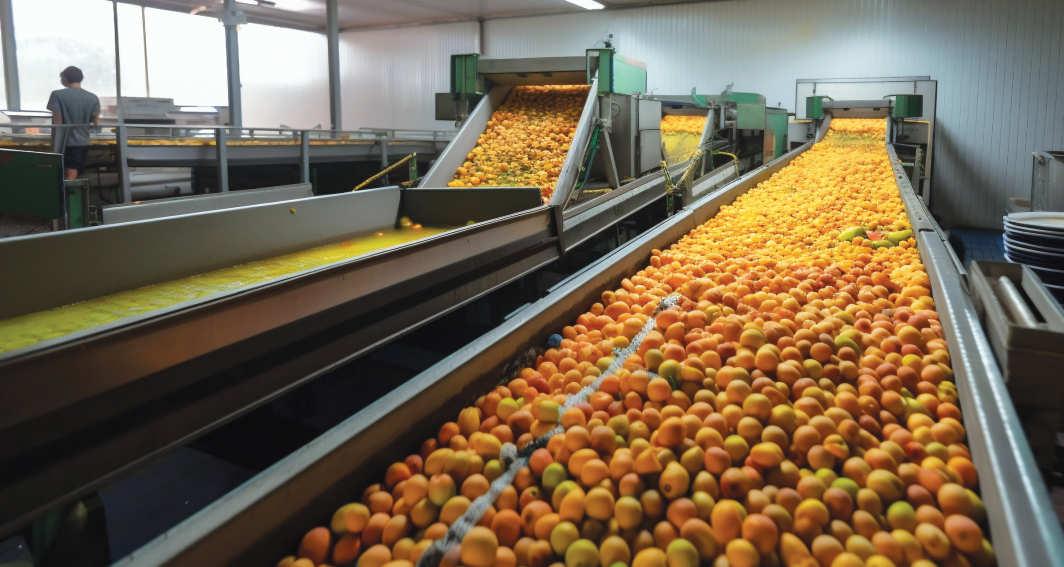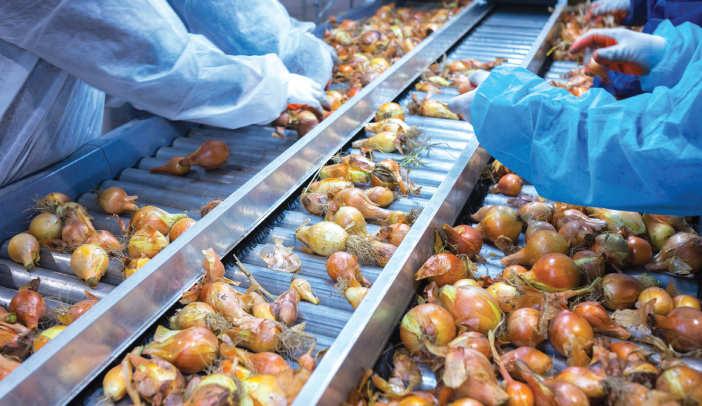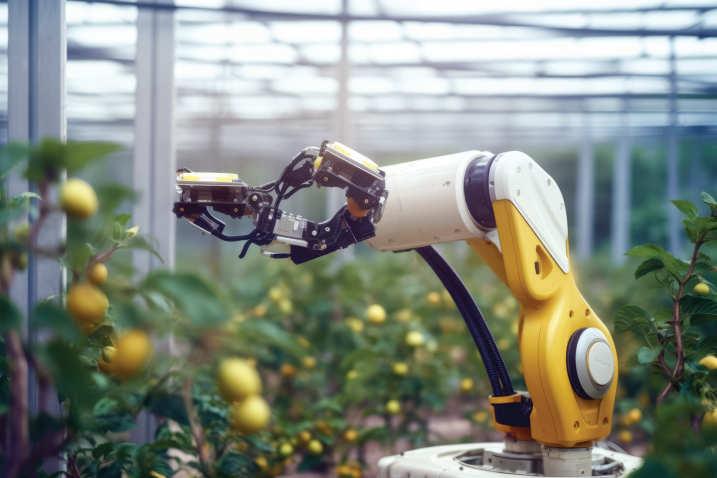
7 minute read
Paving the way for smarter sorting and grading systems
FRUITS AND VEGETABLES once harvested, often fall victim to pests, disease or evaporation of moisture, which physically damages the produce and results in poor yields. Therefore, grading and sorting of the produce is essential to prevent further loss and gain a good price for the yield.
Sorting is a process that separates the good produce from undesirable materials such as stones, leaves, debris, and also immature or rotten produce, ensuring that only the good quality produce passes forward for further processing/the market. The separation is carried out on the basis of a number of factors including shape, weight, size, appearance, and colour. Grading on the other hand, is the classification of the selected produce into classes or grades, based on end use, quality incorporating commercial value, and official standards.
While both these processes were earlier being carried out manually, customer demands and marketing standards have been consistently increasing over the years. Hence, farmers need specific and high- quality equipment to elevate their produce and remove inconsistencies, while also saving money, time and effort.
Sorting and grading machines for fruits and vegetables can be classified into four types, namely screens, roller sorters/ graders, weight sorters/ graders and diverging belts. Also, when comparing the two, grading is generally regarded a tedious process requiring trained experts and top-line equipment.
Significance of AI in grading and sorting
Since artificial neural networks are best suited for issues regarding automated pattern recognition, they can very conveniently be adopted in vegetable sorting and grading processes.
Besides this, using AI offers a plethora of other advantages. For instance, automation can reduce the costs by promoting production efficiency. Automation of vegetable grading and sorting plays a significant role in augmenting the value of produces. Moreover, it adds to the benefit of reducing subjectivity arising from human experts. Overall, automated grading and sorting of vegetables helps in raising the economical gains to a large extent.
A 2022 study presented an accurate vegetable grading system in which artificial neural networks were hybridised with genetic algorithms, in order to eliminate the drawbacks of the existing back propagation algorithm.
The five working phases of the vegetable grading model include:
● Image acquisition: A camera was set up to acquire the images of the vegetable chosen as a sample for the model.
● Pre-processing: At this stage, the images acquired were resized and cropped to fit a fixed size of 100x100. The images were then enhanced using the Weiner filter, which performed less smoothing for regions of large intensity variance and more smoothing for regions of small variance values. This makes the filter especially useful for retaining vegetable edges while smoothing off small bruises on the surface.
● Segmentation: Otsu threshold-based segmentation method was used for separating the vegetable object from the rest of the image.
● Feature extraction: At this stage, two feature sets, namely colour based and shape based feature sets were extracted. Two perimeter values were also taken. Perimeter-O denotes the perimeter value of the object of interest obtained after Otsu segmentation and Perimeter-S denotes perimeter value of vegetable as well as defect (if any) on the vegetable surface. Perimeter-S was then computed using the Sobel edge detection technique. The basic idea behind perimeter compute was to grade the vegetable according to its colour, shape and defect. While color and shape could be directly obtained from features, defects could be indirectly obtained by comparing the Otsu perimeter and Sobel perimeter. A difference in perimeter values indicated that the defect was present. If not, the vegetable could be considered non-defective.
● Vegetable classification: This was regarded as the final step, performed using the hybrid genetic algorithm based back propagation approach. The output of this step was in the form of text that specified the class that the vegetable belonged to. Based on these classes, further grading was performed. The grading rules included: assigning class A to non-defective vegetables, class B to vegetables having nominal surface defects and class C to defective vegetables. Hence, vegetable grading was performed based on these rules.

Overall, the model showed remarkable performance when compared with the existing back propagation neural networks (BPNN). Having achieved an accuracy rate of 93.3% in contrast to BPNN with only 73.3% accuracy, the model has thus been proposed for future perspectives.
Deep learning and its applications in the agricultural sector

Deep learning is basically a subset of machine learning, which is essentially a neural network with three or more layers, attempting to simulate the behaviour of the human brain and allowing it to learn from large amounts of data. Deep learning drives many AI applications and services that improve automation, performing analytical and physical tasks without human intervention. Besides these applications, deep learning also has the potential to revolutionise the agricultural industry by enabling more efficient crop production, precision agriculture, and improved crop monitoring and forecasting.
In the context of fruit and vegetable grading, machine learning can be applied to optical and visual grading systems, which allow fruit images to be analysed by dedicated algorithms. Visual defect detection aided by algorithm-based visual systems is already in use worldwide. Its main goal is to detect as large a set of defects as possible under the form of colour variations, local scratches, bumps and irregular shapes.
Agricultural produce is generally analysed by classical image processing algorithms. In addition, multi-threshold algorithms are also used to isolate phenomena along geometric contour trackers. All these algorithms however, require a tuning effort to ensure accurate performance with minimal false or missdetection. This means that the actual performance is highly dependent on the quality of the visual system and on the effort done in the tuning. A higher skilled operator often ensures better algorithm tuning and performance.
The emergence of modern methods such as deep learning has successfully challenged the human factor in these traditional vision algorithms. This allows the tuning phase to be replaced by automatic learning. RSIP Vision, an established leader in computer vision and image processing R&D, has been using this highly capable technology to revolutionise the grading and sorting processes. The most notable advantage of this technique is its ability to not only be fast and reliable, but also yield a consistent performance.
AI applications in on-farm sorting: future scope and challenges
Although AI and machine learning systems are efficiently designed to perform sorting and grading functions, there is still a long way to go. Research is underway to identify and acknowledge the numerous challenges associated with these systems and ensure that continuous improvements are made to meet future requirements.
RGB and CCD cameras are the most common sensors used for on-farm sorting. However, these cameras can only detect surface and superficial appearance parameters such as shape, color, and size. Therefore, there is currently a demand for sensors that meet the requirements for high throughput function and low cost. While sensors such as hyperspectral cameras, lasers, and NIR for defect detection have been developed for factory sorting lines, more advanced sensors and techniques that offer improved performance in terms of internal disease and defect detection are needed, prior to making this technology widely accessible for adoption in small farms and orchards.
Ongoing research has shown that AI models have proven to be more effective for harvesting than on-farm sorting. Hence, in order to improve the performance of onfarm sorting, research on ripeness and quality detection could be introduced and modified for fruit and vegetable harvesting. Another limitation is the dataset used for the AI model of on-farm sorting. Previously, datasets were mostly used for individual research using limited varieties and cultivars. These collections could result in tendencies of model overfitting and reduce the accuracy of the AI model. Moreover, since data was collected either indoors or outdoors, environmental conditions have affected illumination. As a result, the diversity of datasets for on-farm sorting has not been fully developed.
Hence, it is suggested that additional data samples, including more diverse production circumstances and different cultivars are used, to improve the generalisation ability of AI models. Open-source image datasets could be another solution for expanding the samples to avoid overfitting in AI model training. Furthermore, a findable and accessible dataset that includes more fruit types and varieties conducted in different environmental conditions would be beneficial to expand the dataset for generalisation and development of AI algorithms and to prompt the on-farm sorting industry for small farms and orchards.
On-farm sorting of fruits is generally more profitable than vegetables. Therefore, most farmers are generally hesitant while investing in AI and robotics for on-farm vegetable sorting. In recent years however, organic vegetables that are more dependent on skilled management have started gaining popularity in the fresh market. This is seen as a great opportunity for the development of AI in the on-farm sorting of specialty vegetables such as tomatoes, peppers, and cucumbers.
Initially, researchers only focused on the AI models for the sorting lines of big commercial producers, and the AI models tended to be developed for sorting the produce that was directly transported from farms and orchards to factories, rather than for the on-farm stage that occurs before transportation. Increased costs meant that small farms and orchards had limited access to automated fruit sorting lines. The development of sensor technology and AI models has now opened up the potential for automated fruit sorting in small farms and orchards. In recent years, customer demand for high-quality produce has promoted the on-farm management of small farms and orchards. Consequently, small producers have gradually realised the importance of replacing costly labour with automated sorting systems to save costs and improve efficiency, whereupon AI models for on-farm sorting systems have been introduced.
However, AI models for on-farm sorting are still less focused on researchers compared to those for big factories. The limitation of factory sorting used for onfarm sorting is that the AI models and sensors may not be efficient for the on-farm environment due to operational demands such as lighting, working conditions, and throughput requirements.
As a matter of fact, the purpose of factory and on-farm sorting is the same: to sort and grade produce and remove unwanted items. Therefore, an on-farm fruit sorting system could adopt the AI models developed for factory sorting lines due to their prevalence and effectiveness, but it should be modified and fine-tuned to meet the requirements and environmental conditions of an on-farm operation. Meanwhile, the development of flexible and low-cost sorting lines for on-farm sorting could provide solutions for reducing the costs for big factories. Hence, it is anticipated that the development of AI models for fruit sorting would be beneficial for both factory and on-farm sorting. h












